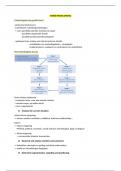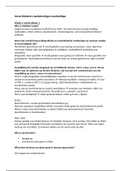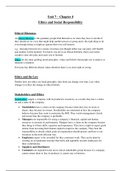Turnaround management & bankruptcy law
Week 1: introduction to business failure, turnaround management and
bankruptcy
What is successful turnaround management?
= Turnaround management may be defined as the process of recovering a firm’s
economic performance following an existence-threatening decline
o If you do not start changing the company, she will go bankrupt
- The decline may occur over several years although there are situations
when extraordinary events occurring over a shorter period of time can
place a firm in distress
- A turnaround may be defined as the recovery of a firm’s economic
performance
- A successful recovery, in its most subdued form, may involve mere survival
with economic performance only just acceptable to the firm’s various
stakeholders. On the other hand, in its most positive form, the recovery
may lead to the firm achieving sustainable, superior competitive positions
in its chosen areas of activity
- How do you turnaround a loss making situation into a profit making
situation?
o If margins improve, more buyers, etc.
We live in a VUCA world, which means that companys do not live in a
stable situation.
Reasons why companies fail? What causus financial distress at
companes?
- Deterministic and voluntaristic explanations for business failure
Deterministic view (‘external factors’)
Principle idea: when it comes to failure, the industry (outside world) matters
more than the firm. It is focused on the external factors. The things that are going
on outside the company.
- Deterministic scholars agree that organizations are embedded in their
environments and, therefore, external factors have more explanatory
power than firm level factors. That is, failure is caused by external factors
over which management has little or no control.
- Also, organizational decisionmakers are assumed to be rational and
committed to acting in the firm’s best interest and, therefore, failure could
not be caused by them alone.
- The deterministic literature suggests a range of primary causes of
organizational failure. These include:
o Turbulent demand structure due to brand switching by core
customers
For example a brand is sometimes very popular and another
time very not popular
o Changes in consumer tastes and preferences
o Cyclical decline in demand
Companies that are operating in markets in which the prices
are very fluctuating
o Increased competition due to rivalry among existing competitors
and or new entrants
o Technological uncertainty due to (disruptive) product innovations
and or process innovations
,Voluntaristic view (‘internal factors’)
The voluntaristic perspective rejects the assumption that managers are
powerless and/or rational actors. Instead, it is predicated on the assumption that
managers are the principal decision makers of the firm, and their perceptions of
the external environment and individual behaviour have a strong effect on how
they (mis)manage the firm.
- Managers, entrepreneurs are the ones who make the big decision within
companies, so if the company goes bankrupt it is because of their
misperception of the external environment. Examples of voluntaristic
explanations
- Curse of success = Existing success confirms our ideas that we always
make the right decisions
o When you had success for quite a while, it confirms unconsciously
that you always make the right decisions.
- Groupthink = The human tendency within organizations to conform to the
group because of the desired harmony, as a result of which critical voices
about the need for intervention are insufficiently heard
o They are not aware that this is happening. But this results in less
critical thinking. Therefore, diversity is important, because then
there is less risk for groupthink.
- Optimism bias = Human tendency to think that they are less susceptible
(gevoelig) to a negative event than others
- Semmelweis reflex = The human tendency not to want to face
uncomfortable truths as it makes us feel responsible
- Similarity bias = The preference or tendency to appreciate “people like
us”. We all gravitate toward people like ourselves in terms of appearance,
beliefs and background because they make us feel comfortable and safe
- Overconfidence bias (“better-than-average-driver”) =
Overconfidence bias is a type of cognitive bias that causes us to think we
are better in some areas than we really are (as compared to others)
- Confirmation bias = The human tendency not to want to face
uncomfortable truths and, above all, to seek confirmation for existing ideas
and beliefs
Conceptual failure model of possible causes of bankruptcy
The causes of bankruptcy can be related to the characteristics of the company
and to the financial symptoms of distress.
Causes of failure and their relationship:
- General Environment: Major economic/technological/political/social shift
o Affect managers’ motivation, the usefulness of their skills and hence
corporate policy, next to the relationship with stakeholders in their
immediate environment.
- Industry Developments: Changing behavior of
customers/suppliers/competitors
o Interactions between a company and its stakeholders determine
corporate development, also, ruinous competition and mutual
projects with stakeholders.
- Management Behavior: Motivation/quality/skills/competence/influence of
personal traits
o Inappropriate management qualities and skills are a threat to firm
survival and are therefore often linked to failure of start-ups.
o If managers are likely to accept advice from other parties, they
significantly reduce a company's long term survival chances.
, o These characteristics include: 1) ignorance of opportunities and
threats instead of exploring changes in strategy and the decision
making processes. 2) Optimism and risk seeking behavior.
- Company's Strategic Policies: Future/current strategic policies, commercial
plan, operational plan, financial policies
- The Company Characteristics: Business model flexibility, company size,
company maturity in the lifecycle
o Liability of newness – young firms have to build up external
legitimacy and stable relationships with stakeholders (very
vulnerable).
o Size affects survival chances, but has less importance than newness.
o Companies in different industries, even with a similar financial
profile, have a different probability of failure.
They make the abstract approach applicable in a concrete analysis model.
Failure as a process: 4 typologies
1. The failure process of an unsuccesful start-up company
Many enterprises have a weak business plan. Entrepreneurs initiate businesses
without thoroughly considering the opportunities. Additionally, startups are often
led by individuals with limited management and entrepreneurial experience. This
combination can be fatal.
- Many companies fail before 5 years
- Main causes: lack of managerial or industry-related experience
- Errors made by management that lead to negative signals: o Heavy capital
expenditures, low sales levels & underestimated expenses
- These negative signals are rapidly followed by financial indicators of
distress o Low cash flow and profitability inevitably leads to liquidity
problems, often increased by unadjusted investments
- The lack of external legitimacy and stakeholders’ mistrust accelerate the
failure process
- Management gradually realize the necessity of a restructuring, but banks
refuse cooperation o Cannot escape the downward spiral
, 2. The failure process of an ambitious growth company
The leaders of these companies are experienced and smart, but they like taking
big risks. They have banks that support them financially to grow. They dream big
and believe strongly in their growth plans. They spend money upfront, like
investing and making deals, hoping for profits later.
But sometimes, they're not flexible enough to change their plans as they grow.
Costs start to pile up, and despite their efforts, the business doesn't grow as fast
as they hoped. They struggle to adapt to unexpected changes. Eventually, they
run out of money, and the people who invested in them lose faith. This leads to
bankruptcy.
- From the start, ambitious growth & objectives
- Causes: management’s overestimation of turnover combined with
vulnerability towards changes in the environment is another possible cause
for bankruptcy after failed growth.
- An over-optimist expansion plan is launched which implies a major
increase of the firm’s debt/equity ratios
- Overestimation of sales is due to over- optimism or to an overestimation of
either market size or customers’ switching behavior
- Turnover is insufficient to cover expenses and overcapacity is large,
because it is very difficult without internal means and banks mostly refuse
additional debt.
- Due to its financial structure, the company is vulnerable to changes in the
environment.
3. The failure process of a dazzled growth company
Businesses aiming for incredibly fast growth often have an innovative business
model, are highly ambitious, employ highly educated and experienced staff, with
the goal of becoming a billion-dollar company. However, there's a risk of
becoming overly optimistic at some point. When you believe so strongly in
growth that everything else takes a back seat, the cost of expansion can be
extremely high.
Initially, the growth model seems sound, with investments and the right people
on board. However, there comes a point where overestimation of revenue and
profitability occurs. Eventually, someone might ignore signs that the growth isn't
as remarkable as expected. Despite sustaining for a while, the inability to
convince financiers of continued growth leads to collapse.
- Deterioration and bankruptcy of a company after a failing growth
- Initially, internal or external growth is desired: a new strategy is
developed, which is successful and the company gains legitimacy as one of
the most promising companies in the industry
- The initial shortcoming is management’s reaction to this success:
dangerously dazzled over-optimism
o Growth and capital expenditures increase together with leverage,
pitfalls are ignored and the organizational structure remains almost
unchanged
o Loss of control and unawareness of possible issues that could affect
operational efficiency
- Negative signals: overestimated sales, large overcapacity and high
expenses.
- Causes: extreme optimism and unrealistic perceptions, negative signals
are ignored or attributed to external factors
o Need for internal restructuring.
Week 1: introduction to business failure, turnaround management and
bankruptcy
What is successful turnaround management?
= Turnaround management may be defined as the process of recovering a firm’s
economic performance following an existence-threatening decline
o If you do not start changing the company, she will go bankrupt
- The decline may occur over several years although there are situations
when extraordinary events occurring over a shorter period of time can
place a firm in distress
- A turnaround may be defined as the recovery of a firm’s economic
performance
- A successful recovery, in its most subdued form, may involve mere survival
with economic performance only just acceptable to the firm’s various
stakeholders. On the other hand, in its most positive form, the recovery
may lead to the firm achieving sustainable, superior competitive positions
in its chosen areas of activity
- How do you turnaround a loss making situation into a profit making
situation?
o If margins improve, more buyers, etc.
We live in a VUCA world, which means that companys do not live in a
stable situation.
Reasons why companies fail? What causus financial distress at
companes?
- Deterministic and voluntaristic explanations for business failure
Deterministic view (‘external factors’)
Principle idea: when it comes to failure, the industry (outside world) matters
more than the firm. It is focused on the external factors. The things that are going
on outside the company.
- Deterministic scholars agree that organizations are embedded in their
environments and, therefore, external factors have more explanatory
power than firm level factors. That is, failure is caused by external factors
over which management has little or no control.
- Also, organizational decisionmakers are assumed to be rational and
committed to acting in the firm’s best interest and, therefore, failure could
not be caused by them alone.
- The deterministic literature suggests a range of primary causes of
organizational failure. These include:
o Turbulent demand structure due to brand switching by core
customers
For example a brand is sometimes very popular and another
time very not popular
o Changes in consumer tastes and preferences
o Cyclical decline in demand
Companies that are operating in markets in which the prices
are very fluctuating
o Increased competition due to rivalry among existing competitors
and or new entrants
o Technological uncertainty due to (disruptive) product innovations
and or process innovations
,Voluntaristic view (‘internal factors’)
The voluntaristic perspective rejects the assumption that managers are
powerless and/or rational actors. Instead, it is predicated on the assumption that
managers are the principal decision makers of the firm, and their perceptions of
the external environment and individual behaviour have a strong effect on how
they (mis)manage the firm.
- Managers, entrepreneurs are the ones who make the big decision within
companies, so if the company goes bankrupt it is because of their
misperception of the external environment. Examples of voluntaristic
explanations
- Curse of success = Existing success confirms our ideas that we always
make the right decisions
o When you had success for quite a while, it confirms unconsciously
that you always make the right decisions.
- Groupthink = The human tendency within organizations to conform to the
group because of the desired harmony, as a result of which critical voices
about the need for intervention are insufficiently heard
o They are not aware that this is happening. But this results in less
critical thinking. Therefore, diversity is important, because then
there is less risk for groupthink.
- Optimism bias = Human tendency to think that they are less susceptible
(gevoelig) to a negative event than others
- Semmelweis reflex = The human tendency not to want to face
uncomfortable truths as it makes us feel responsible
- Similarity bias = The preference or tendency to appreciate “people like
us”. We all gravitate toward people like ourselves in terms of appearance,
beliefs and background because they make us feel comfortable and safe
- Overconfidence bias (“better-than-average-driver”) =
Overconfidence bias is a type of cognitive bias that causes us to think we
are better in some areas than we really are (as compared to others)
- Confirmation bias = The human tendency not to want to face
uncomfortable truths and, above all, to seek confirmation for existing ideas
and beliefs
Conceptual failure model of possible causes of bankruptcy
The causes of bankruptcy can be related to the characteristics of the company
and to the financial symptoms of distress.
Causes of failure and their relationship:
- General Environment: Major economic/technological/political/social shift
o Affect managers’ motivation, the usefulness of their skills and hence
corporate policy, next to the relationship with stakeholders in their
immediate environment.
- Industry Developments: Changing behavior of
customers/suppliers/competitors
o Interactions between a company and its stakeholders determine
corporate development, also, ruinous competition and mutual
projects with stakeholders.
- Management Behavior: Motivation/quality/skills/competence/influence of
personal traits
o Inappropriate management qualities and skills are a threat to firm
survival and are therefore often linked to failure of start-ups.
o If managers are likely to accept advice from other parties, they
significantly reduce a company's long term survival chances.
, o These characteristics include: 1) ignorance of opportunities and
threats instead of exploring changes in strategy and the decision
making processes. 2) Optimism and risk seeking behavior.
- Company's Strategic Policies: Future/current strategic policies, commercial
plan, operational plan, financial policies
- The Company Characteristics: Business model flexibility, company size,
company maturity in the lifecycle
o Liability of newness – young firms have to build up external
legitimacy and stable relationships with stakeholders (very
vulnerable).
o Size affects survival chances, but has less importance than newness.
o Companies in different industries, even with a similar financial
profile, have a different probability of failure.
They make the abstract approach applicable in a concrete analysis model.
Failure as a process: 4 typologies
1. The failure process of an unsuccesful start-up company
Many enterprises have a weak business plan. Entrepreneurs initiate businesses
without thoroughly considering the opportunities. Additionally, startups are often
led by individuals with limited management and entrepreneurial experience. This
combination can be fatal.
- Many companies fail before 5 years
- Main causes: lack of managerial or industry-related experience
- Errors made by management that lead to negative signals: o Heavy capital
expenditures, low sales levels & underestimated expenses
- These negative signals are rapidly followed by financial indicators of
distress o Low cash flow and profitability inevitably leads to liquidity
problems, often increased by unadjusted investments
- The lack of external legitimacy and stakeholders’ mistrust accelerate the
failure process
- Management gradually realize the necessity of a restructuring, but banks
refuse cooperation o Cannot escape the downward spiral
, 2. The failure process of an ambitious growth company
The leaders of these companies are experienced and smart, but they like taking
big risks. They have banks that support them financially to grow. They dream big
and believe strongly in their growth plans. They spend money upfront, like
investing and making deals, hoping for profits later.
But sometimes, they're not flexible enough to change their plans as they grow.
Costs start to pile up, and despite their efforts, the business doesn't grow as fast
as they hoped. They struggle to adapt to unexpected changes. Eventually, they
run out of money, and the people who invested in them lose faith. This leads to
bankruptcy.
- From the start, ambitious growth & objectives
- Causes: management’s overestimation of turnover combined with
vulnerability towards changes in the environment is another possible cause
for bankruptcy after failed growth.
- An over-optimist expansion plan is launched which implies a major
increase of the firm’s debt/equity ratios
- Overestimation of sales is due to over- optimism or to an overestimation of
either market size or customers’ switching behavior
- Turnover is insufficient to cover expenses and overcapacity is large,
because it is very difficult without internal means and banks mostly refuse
additional debt.
- Due to its financial structure, the company is vulnerable to changes in the
environment.
3. The failure process of a dazzled growth company
Businesses aiming for incredibly fast growth often have an innovative business
model, are highly ambitious, employ highly educated and experienced staff, with
the goal of becoming a billion-dollar company. However, there's a risk of
becoming overly optimistic at some point. When you believe so strongly in
growth that everything else takes a back seat, the cost of expansion can be
extremely high.
Initially, the growth model seems sound, with investments and the right people
on board. However, there comes a point where overestimation of revenue and
profitability occurs. Eventually, someone might ignore signs that the growth isn't
as remarkable as expected. Despite sustaining for a while, the inability to
convince financiers of continued growth leads to collapse.
- Deterioration and bankruptcy of a company after a failing growth
- Initially, internal or external growth is desired: a new strategy is
developed, which is successful and the company gains legitimacy as one of
the most promising companies in the industry
- The initial shortcoming is management’s reaction to this success:
dangerously dazzled over-optimism
o Growth and capital expenditures increase together with leverage,
pitfalls are ignored and the organizational structure remains almost
unchanged
o Loss of control and unawareness of possible issues that could affect
operational efficiency
- Negative signals: overestimated sales, large overcapacity and high
expenses.
- Causes: extreme optimism and unrealistic perceptions, negative signals
are ignored or attributed to external factors
o Need for internal restructuring.










